|
Home
Up
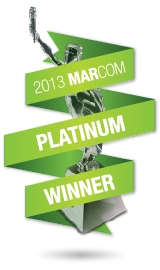
Marcom Award
2007-2008-2009
2010-2011-2012
2013-2014

Videographer Award
2007-2008-2009
2010-2013-2015
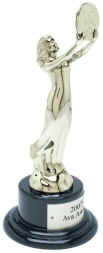
AVA Award Winner
2007-2008-2009
2010-2011-2012
2013-2014-2015
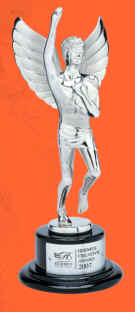
2008-2009-2010
2011-2012-2013
2014
Hermes Creative
Award Winner

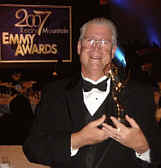
Ed
Sharpe / CouryGraph Productions
Glendale Daily Planet / KKAT-IPTV 2007 EMMY®Award Winner
2007
Rocky Mountain Region Emmy® Award Winner for Breaking News/ Continuing
Coverage
FIRST
IN GLENDALE!

Berkeley Film Festival
Grand Festival
Pioneer In
Television Award
2011

Remi Award Winner
Worldfest Houston
2009 - 2010 -2011

2009 EMPixx Awards
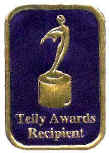
Telly Awards 2006-2007-2008-2009-2010
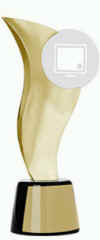
2008 & 2009
Communicator Awards
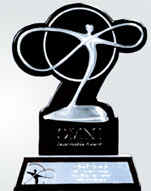
Omni Intermedia Awards
2007-2008-2009

Millennum Awards
2006-2007-2008
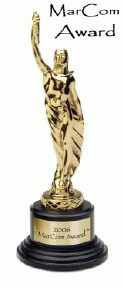
Marcom Award
2007-2008-2009
2010-2011-2012
2013-2014
 
W3 Media Awards
2008/2009
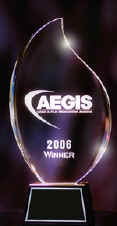
2007/2008/2009 Aegis
Finalists and Winners

Accolade Award Winner
2007-2008-20010
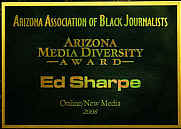
Arizona Assn. of Black Journalists Diversity Winner
2008/2009
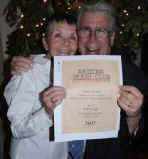
Arizona Press Club Winner
Ed Sharpe,
The Glendale Daily Planet:
Use of Online Media
"Cesar E. Chavez 2007"
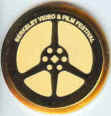
Berekeley Film Festival
2006-2007-2008-
2009-2010-2012
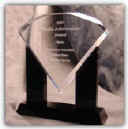
Media Achievement Awards

2008/09 Finalists and Winners - DV Awards

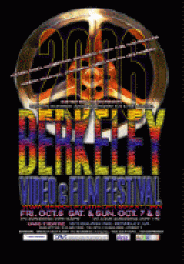
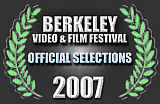
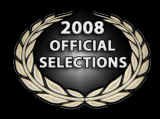
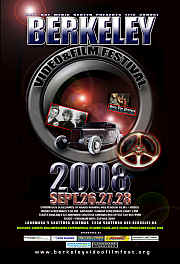

CouryGraph
Productions



CALIFORNIA
HISTORICAL RADIO SOCIETY
IS PLEASED TO HONOR
EDWARD
A. SHARPE
WITH THE
CHARLES D. 'DOC' HERROLD
AWARD FOR
OUTSTANDING ACHIEVEMENT IN
THE PRESERVATION AND DOCUMENTATION OF
EARLY RADIO.
BY
THE BOARD OF DIRECTORS, 1992:

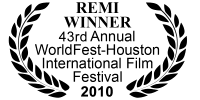
| |
Jim
Lehrer and Robert MacNeil - 25th Annual Walter Cronkite
Award Winners.
Ed
Sharpe - Glendale Daily Planet - 11/21/2008
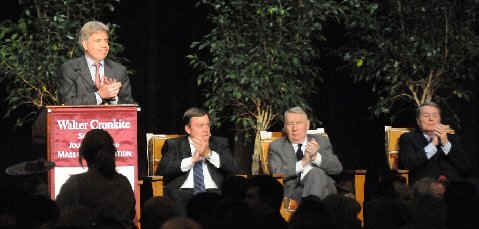
Photo By Ed Sharpe - Glendale Daily Planet
ASU
Cronkite School of Journalism Dean Chris Callahan Introduces
ASU President Michael M. Crow, Robert MacNeil and Jim
Lehrer During the 25th annual Walter Cronkite
Award at the Cronkite Luncheon Friday, Nov. 21, at the
Arizona Biltmore Resort and Spa.
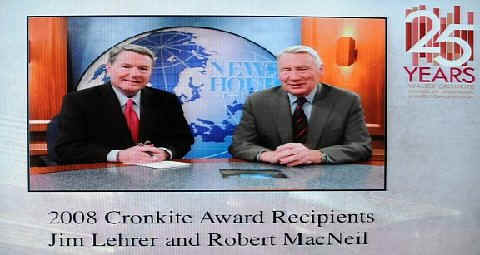
(Award luncheon screenshot)
Phoenix
AZ - Long-time PBS journalists Jim Lehrer and Robert MacNeil
received the 25th annual Walter Cronkite Award at the Cronkite
Awards Luncheon, Friday, Nov. 21, at the Arizona Biltmore
Resort and Spa, located at 2400 E. Missouri Ave. Over
one thousand participants were treated to a great meal, wise
words offered by MacNeil and Lehrer, and some great history on
this dynamic duo.
Attendees
learned about the school's progress and success with it's new
facility. Other honors were bestowed at this luncheon to the
executive editor of The Arizona Republic, Nicole Carroll, the
newest member of the Cronkite Alumni Hall of Fame.
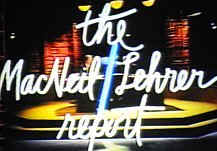
(Award luncheon screenshot)
The
executive producer of The NewsHour, Les Crystal, and NewsHour
correspondents Gwen Ifill and Judy Woodruff congratulated the
honorees in a video shown after Crow’s introduction.
“Journalism
has seen a lot of ups and downs in the last 25 years, but the
NewsHour has stayed true to what Jim and Robin envisioned,”
Woodruff said. She joked that when she first joined “The
MacNeil/Lehrer NewsHour,” she sometimes forgot which one was
which. “I still have trouble telling them apart,” she
said, “but I do know that no one else comes close, except
Walter Cronkite.”
The PBS duo first teamed up to cover the Senate Watergate
hearings in 1973. Two years later, the newscast that would
become “The MacNeil/Lehrer Report” was launched and was
expanded to “The MacNeil/Lehrer NewsHour” in 1983. MacNeil
stepped down from the daily newscast in 1995 and Lehrer
continues to anchor “The NewsHour with Jim Lehrer.” They
have covered stories such as Watergate, the civil rights
movement, the White House and the assassination of John F.
Kennedy. Both are prolific authors and have won numerous
awards including George Foster Peabody,Fred Friendly
First Amendment and Emmy(R) Awards.
They were inducted into the Television Academy’s Hall of
Fame in 1999.
Unfortunately
the passage of time has limited Walter Cronkite's
travels and this year he was not present at the
awards. Cronkite did send a letter expressing his
congratulations. “I am deeply honored that two great
journalists, Jim Lehrer and Robert MacNeil, have agreed to
accept the 25th Cronkite Award for Excellence in Journalism,” he
stated.
Lehrer
and MacNeil are the second joint winners of the Cronkite Award.
CBS founder William Paley and former CBS President Frank Stanton
received the inaugural award in 1984.
“The
Cronkite Award is a kind of Holy Grail for people like us who do
television journalism,” Lehrer said after accepting his award.
“To be honored in the name of the best—Walter Cronkite—is
as good as it gets.”
He
shared many wise words relating to what people are interpreting
as journalism.
The
video of
his speech is at
http://www.smecc.org/media/cronkite_fin-256.wmv
"The
bloggers are mostly reactors commentators, not reporters
The talk show hosts are provocateurs commentators, not reporters
The comedians are entertainers commentators, not reporters
The search engines search, but they don't report"
He
also stated, "You want to be entertained? Go to
the circus for god's sake...don't watch the NEWS HOUR . I never
want people to confuse the news with entertainment or.. me with
the crowns!"
Lehrer
defined his rules of journalism he developed during several
years ago at a seminar being held at the Aspen Institute.
Do nothing I cannot defend
Cover, write and present every story with the care I would want if the story were about me
Assume there is at least one other side or version to every story
Assume the viewer is as smart and as caring and as good a person as I am
Assume the same about all people on whom I report
Assume personal lives are a private matter until a legitimate turn in the story absolutely mandates otherwise
Carefully separate opinion and analysis from straight news stories and clearly label everything
Do not use anonymous sources or blind quotes except on rare and monumental occasions.
No one should ever be allowed to attack another anonymously
And finally, finally I am not in the entertainment business
Reflecting
back on a job from his youth, a bus caller in a depot in
Victoria Texas, Lehrer commented on the power of education
stating "If you learn something early, and you learn it
well and it is totally irrelevant you will never forget
it!"
He then treated us to a bus call.... "Now may I have
your attention please....
This is your last call for Continental Trailways 6:40 p.m.,
Silversides air conditioned Thruliner to San Antonio now leaving
from lane one for ..."
(A lengthy list of town names obscured by loud applause
from audience)
Connecting in San Antonio for Del Rio, Van Horne El Paso Las
Cruces and Phoenix.
"All
Aboooooord!
Don't forget your baggage please!"
Robert
MacNeil, the other half of the dynamic duo related stories
of retirement, how people still confuse their names.
"A
journalism education is probably today the best general
education that an American citizen can get. I know a lot of
people thing the law is probably the best basic education, and
it is great, but journalism forces people to acquire skills that
are in huge demand and very scarce in this society the ability
top assimilate large amounts often of complicated information,
to distill the essence and what is important from that and
reproduce it in simple plain English that ordinary people can
understand. Those are skills that businesses are craving to
have."
MacNeil,
also related the uses and distortions of language with examples
form today's pubic relations organizations in addition to
historic examples of Orwell's New Speak and thoughts and ideas
put forth by the Stalinist regime in the past.
MacNiel went into depth on how terms of "Fair and
Balanced" "Investigative
Reporting"" In Depth Reporting" were used , but
more importantly how these terms are abused in the field of
journalism.
(The full video of this amazing speech will be up later on
Glendale Daily Planet - http://www.glendaledailyplanet.com
)
Previous
Cronkite Award recipients include TV journalists Tom Brokaw,
Bill Moyers and Jane Pauley; newspaper publishers Al Neuharth,
Katharine Graham and Otis Chandler; television executives Ted
Turner, Roone Arledge and Don Hewitt; and newspaper journalists
Bob Woodward, Helen Thomas and Ben Bradlee.
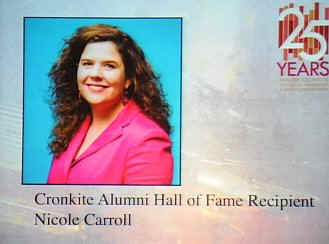
(Award luncheon screenshot)
Other
honors were bestowed at this luncheon to the executive editor
of The Arizona Republic, Nicole Carroll, the newest
member of the Cronkite Alumni Hall of Fame.
Carroll, who graduated from the Cronkite School in 1991, was
named to the Republic’s No. 2 newsroom position earlier this
year. At age 40, she is one of the youngest executive editors
of a major metropolitan newspaper.
“It’s remarkable how much Nicole Carroll has accomplished
in journalism already,” said Cronkite Dean Christopher
Callahan. “She’s a rising star in journalism, and we're
honored to include her in the school’s Hall of Fame.”
Reflecting
on the news campus, ASU President Michael Crow stated
during the introduction, “Not only are we dedicating
this new facility, but we're recognizing two individuals who,
in their entire lives, epitomized what we want to be, what we
want to do and the kind of people we want to produce.”

(Award luncheon screenshot)
During
the luncheon, Dean Chris Callahan treated us to a
short video by Cronkite graduate David Klee that used time-lapse
images to show the progress of the new Cronkite School of
Journalism building in downtown Phoenix. The screen came
alive with color, motion and a growing building!
Callahan
stated, "This year’s ceremony is especially significant
for the Cronkite School," This year's luncheon marks the 25th anniversary of the Cronkite
Award and concluded a week of activities celebrating the grand
opening of the school’s new state-of-the-art journalism
building in downtown Phoenix. Callahan emphasized,
“Today our new home is the most sophisticated,
forward-looking, journalism education complex in the nation,”
After the awards and back at Cronkite School of
Journalism...
Later
in the day, former lead CNN anchor and Walter Cronkite Professor
of Journalism Aaron Brown hosted a conversation with Bob
Woodruff of ABC who was injured in Iraq while covering the war.
MacNeil and Lehrer also joined the conversation about the future
of TV journalism. Approximately 200 students and visitors turned
out for the presentation.
(Information and photo sources - meeting notes, Glendale
Daily Planet / KKAT-IPTV Video Tape, Glendale Daily Planet
still photos, ASU News Releases and memory.)
New Clifford Gallery Honors Journalism
History
By Ed Sharpe
with some additional supplied text.

ASU
Cronkite School of Journalism Dean Chris Callahan presents
a plaque to Jack Clifford,
benefactor of the The Marguerite and
Jack Clifford Gallery that houses a most excellent
history of journalism display. Photo by Ed Sharpe
A gallery honoring the career of Walter
Cronkite and the history of journalism is now open at the Walter
Cronkite School of Journalism and Mass Communication at Arizona
State University.
The Marguerite and Jack Clifford Gallery
was dedicated Nov. 19 before a crowd of nearly 100 people,
including Clifford, the veteran TV executive for whom the gallery
is named.
The 1,500-square-foot gallery houses
artifacts of the history of journalism, including items from the
school’s namesake, Walter Cronkite. It is located on the second
floor of the Cronkite School’s new building at 555 N. Central
Ave. and is open to the public.
“It is an honor to be associated with
the gallery because it is important to me that students for
generations to come know about journalism history and understand
Mr. Cronkite’s important role in it,” said Clifford, the
founder of the Food Network and a longtime supporter of the
Cronkite School.
Hundreds of items are on display,
including pipes and books from Cronkite’s New York office, a
microphone used by Edward R. Murrow in 1938, and collections of
typewriters and broadcast editing equipment. Artifacts of local
significance include a Phoenix Gazette street sales box with a
copy of the last issue of the paper from 1997 and early mini-cam
equipment used by the news department of KOOL-TV, the forerunner
of KSAZ-TV in Phoenix.
Most of the items were donated or loaned
by individuals and organizations, including Cronkite, Ed Sharpe's
SMECC in Glendale AZ, the House of Broadcasting, The Arizona
Republic and Cronkite faculty.
Professor John Craft, the senior member
of the Cronkite faculty, oversaw the selection and display of
items.
The gallery is named after Clifford, who
launched his television career in Phoenix in 1957. He was
president and general manager of KTAR-TV in Phoenix, and held
similar positions at other stations around the country before
joining the Providence Journal Co. in Rhode Island, where he was
executive vice president. Clifford developed the company’s
electronic media business into one of the nation’s largest
broadcast TV, cable television and TV programming companies. He
founded and was chairman of both the Food Network and Northwest
Cable News.
Clifford currently is a member of both
the ASU Foundation Board of Trustees and the Cronkite Endowment
Board.
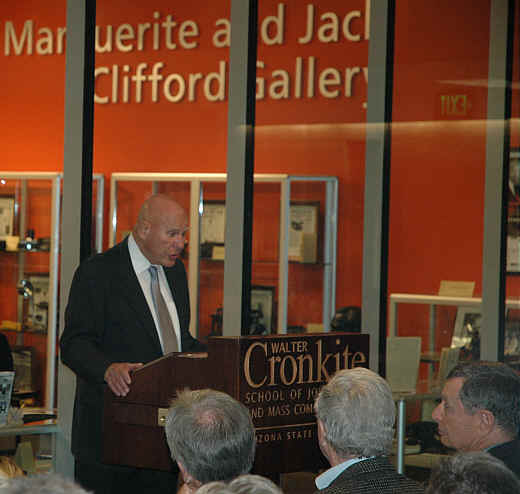
Jack Clifford addresses
visitors at the dedication of The Marguerite and Jack Clifford Gallery
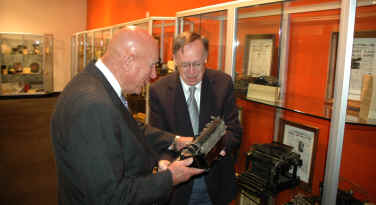
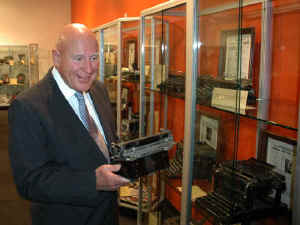
Jack Clifford and
Professor John Craft prepare the last piece to go in the display
on the opening day ceremony of The Marguerite and Jack Clifford Gallery
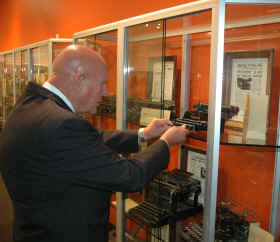

Jack Clifford inserts the
last piece Right- Artists rendering of the
Campus
|
| |
|
|
| TV on Wheels Only
$99 plus freight!
Learn about the history of
remote trucks!
|
 TV
on Wheels Book : This is the first complete book ever written
with tons of information on video and audio production trucks.
It covers every aspect from satellite and microwave vans, remote
pro audio trucks on up to the newest ten million dollar HD slide
out trailers you see at concerts and Super Bowl games. Costs,
technology, how they are built and designed, accidents and a
full history of broadcast trucks are covered. The book,
published in 2003, is a hard bound, glossy, coffee table quality
book, 218 pages in length, with nearly 700 photographs and
diagrams, most of which are in color. Whether you are involved
with one camera live shots, satellite uplinks, or take part in
the marquee events that require large truck compounds this book
celebrates the TV and audio truck industry. This book explains
the industry on three levels as well as a picture essay of the
business. It also provides nearly 70,000 words of narration to
tie the pictures into a story. Want to delve a little deeper
into some of the technical and production issues involved? The
book has dozens of sidebars that look a little further under the
hood of this interesting industry. From concept, to planning,
through setup to air time the reader walks through the process
of performing television on location. Whether you are building
your own truck, retrofitting an existing truck or just plain
interested in mobile audio and video --this book packs a ton of
real world information between its covers. By Jim Boston &
George Hoover : TV on Wheels
Only $99 plus freight! Learn about
the history of remote trucks! TV
on Wheels Book : This is the first complete book ever written
with tons of information on video and audio production trucks.
It covers every aspect from satellite and microwave vans, remote
pro audio trucks on up to the newest ten million dollar HD slide
out trailers you see at concerts and Super Bowl games. Costs,
technology, how they are built and designed, accidents and a
full history of broadcast trucks are covered. The book,
published in 2003, is a hard bound, glossy, coffee table quality
book, 218 pages in length, with nearly 700 photographs and
diagrams, most of which are in color. Whether you are involved
with one camera live shots, satellite uplinks, or take part in
the marquee events that require large truck compounds this book
celebrates the TV and audio truck industry. This book explains
the industry on three levels as well as a picture essay of the
business. It also provides nearly 70,000 words of narration to
tie the pictures into a story. Want to delve a little deeper
into some of the technical and production issues involved? The
book has dozens of sidebars that look a little further under the
hood of this interesting industry. From concept, to planning,
through setup to air time the reader walks through the process
of performing television on location. Whether you are building
your own truck, retrofitting an existing truck or just plain
interested in mobile audio and video --this book packs a ton of
real world information between its covers. By Jim Boston &
George Hoover : TV on Wheels
Only $99 plus freight! Learn about
the history of remote trucks!
Coury House / SMECC
5802 W. Palmaire Ave
Call Us at 623-435-1522
Glendale, AZ 85301
|
| IN STOCK! - Limited quantity left - |
Cronkite
School celebrates 25 years of excellence
Arizona
State University’s journalism program has experienced an amazing
evolution during the past 25 years.
Technology changed the way that students work from the demise of
the typewriter to the advent of video display terminals. Laptop
computers, email and the Internet are modern-day tools of the
trade.
What hasn’t changed are the basic tenants of journalism.
As the Walter Cronkite School of Journalism and Mass Communication
celebrates its 25th anniversary, the school continues to teach
professional journalism ethics while expanding its offerings to
embrace the multimedia age.
Highlights throughout the years have been many. One of the biggest
was naming the school after Walter Cronkite, the CBS news anchor
who was an essential member of American’s households during the
1960s.
“The landing of the Cronkite name - thanks to Tom Chauncey -
in 1983 was, of course, huge,” said Doug Anderson, who
joined the school in 1979 as a professor and served as director
from 1987 to 1999. Chauncey, the owner of the local CBS affiliate,
contacted Cronkite and asked him to help the school.
Other milestones included broadcast students earning real-world
experience when the school’s weekly television newscast called
“Southwinds” was launched in 1989. (Today’s broadcast
students host Cronkite NewsWatch three days a week from the school’s
new building downtown.) Cronkite students also began dominating
the William Randolph Hearst Foundation's Journalism Awards Program
during the 1990s, elevating the school’s reputation and
showcasing the best work that budding journalists were turning
out. They also worked at Valley newspapers, radio stations,
television stations and public relations outlets through
internships established during Anderson’s tenure.
Today’s students continue to dominate the Hearst awards.
“That is a great measure of the quality of a journalism
program,” said Christopher Callahan, current dean of the
Cronkite School.
Landing the sixth $1.5 million Knight Chair from the John S. and
James L. Knight Foundation in the 1990s was another milestone that
took Cronkite from a nationally known program to a top-10
journalism school.
“The Cronkite School was among the first 10 journalism
programs in the nation to receive the Hearst Foundation's Visiting
Professionals Program endowment and was among the first nine to be
selected for the Freedom Forum's Professional-in-Residence
program,” Anderson said. “Another of many highlights
was having the privilege of being able to hire so many bright,
talented and hard-working professors to make the school far more
nationally formidable than anyone would have dreamed possible.”
The Cronkite School took another leap forward in 2004 when ASU
President Michael Crow announced that the school would become an
independent unit and be an integral part of the new Downtown
Phoenix campus.
Since arriving at ASU three years ago as dean of the Cronkite
School, Christopher Callahan has continued to raise the quality of
the school with a new curriculum that emphasizes hands-on,
multimedia training, star faculty who bring years of media
experience to students and a state-of-the-art journalism complex
in the heart of the city.
“We’re really living in the digital age. This school –
more than any in the country – embraces that,” Callahan
says.
But the Cronkite School keeps traditional journalism values at the
heart of its core mission – teaching students to write and
broadcast objective, comprehensive stories under tight deadlines
using digital skills that are increasingly in demand.
“Those students are highly sought out,” Callahan
said.
So are the faculty who teach them from former CNN anchor Aaron
Brown to former BET executive Retha Hill. Relative newcomers join
veterans such as Frederic “Fritz” Leigh who served as the
Cronkite School’s first associate director and started ASU’s
campus radio station in 1982.
“It’s a great mix of high-level professionals coming out
of newsrooms and professional scholars,” Callahan said.
Recent Cronkite students have benefited from an expanded faculty
that has doubled in size during the past three years. Partnerships
with major corporations such as Gannett, Knight Foundation and
Carnegie Corporation build the school’s programs and reputation
for excellence.
The school’s new 223,000 square feet, six-story building in the
heart of downtown Phoenix offers students the chance to learn in a
state-of-the-art facility equipped with seven digital media
laboratories, seven digital computer labs, five working newsrooms
and two TV studios with adjoining digital control rooms for daily
newscasts and satellite feeds.
“This is one of the best journalism schools in the country
today,” Callahan said.
The new building, which Cronkite shares with Eight/KAET, also
reflects the most important values of great journalism.
Floor-to-ceiling versions of the First Amendment are displayed on
each of the six floors, and inspirational quotes about journalism
and the free press are visible throughout the building.
With a past that is built on excellence, the school’s future
looks bright.
“Over the next 3 to 5 years, we’ll take the Cronkite
School to the top school in the country by focusing on the future
and traditional journalism values,” Callahan said.
Dedication
of New Cronkite Home Set
PHOENIX
- A week of special events Nov. 17-21 will mark 25 years of the
Walter Cronkite School of Journalism and Mass Communication and
the dedication of the school’s new building in downtown
Phoenix.
The
week includes a dedication ceremony with Arizona State
University President Michael Crow, Phoenix Mayor Phil Gordon and
Walter Cronkite, guided tours of the building for the public,
and a series of speakers and panel discussions on issues facing
journalists. It will culminate in the 25th annual Walter
Cronkite Award Luncheon honoring long-time PBS television
journalists Jim Lehrer and Robert MacNeil.
The
Cronkite School’s new $71 million building in the heart of
downtown Phoenix opened for classes Aug. 25 following a
breakneck 18-month construction project that was launched after
Phoenix voters overwhelmingly approved a bond issue that
included the Cronkite project.
The building, which also will house one of the country’s
largest PBS stations, KAET/Eight, is an ultra-modern structure
of glass, steel and concrete built by Sundt Construction Inc.
and designed by Steven Ehrlich Associates in partnership with
HDR Architecture. It rises six stories along North Central
Avenue, two blocks north of Van Buren Street.
The building and its technology are considered unmatched in
journalism education. Students have access to state-of-the-art
technology, including seven professional newsrooms and media
incubators, seven other digital computer labs, 17 fully mediated
classrooms, nearly 1,000 classroom seats and 280 digital
workstations.
The space is about five times the size of the school’s
previous home, Stauffer Hall, on the Tempe campus.
The Cronkite Week celebration will feature nationally and
locally known journalists who will lead discussions on topics
ranging from journalism ethics and diversity to the press and
politics and challenges facing journalists in a digital media
age.
Visitors
will be able to view a National Press Club documentary and a PBS
documentary on Walter Cronkite as well as an Associated Press
photo exhibit of U.S. Presidents. They may listen to the
building’s architects and artists talk about their work and
attend dedication ceremonies for the Sony Television Studio and
the Marguerite and Jack Clifford Gallery, which features
artifacts from journalism history and items from Walter
Cronkite.
All
events are open to the public. Tickets are required for selected
events. Following is a full schedule of events:
Cronkite Week 2008
Celebrating Our New Home, New Era
& 25 Years of Excellence
Monday,
Nov. 17 – A Look Back: Journalism History and Traditions
100
Years of Journalism: A National Press Club Documentary
1:30-3:30 p.m. | Cronkite Theater
Followed by a conversation with Gil Klein, former Washington
correspondent and National Press Club president
U.S.
Presidents through the Photojournalist’s Lens: An Associated
Press Exhibit
4-5:15 p.m. | The First Amendment Forum
Featuring J. David Ake, Washington photo editor, The Associated
Press
Reception
5:30-6:15 p.m. | The First Amendment Forum
Reception honoring the Cronkite Endowment Board, Cronkite
faculty and Cronkite staff
Cronkite
School in Year 25:
A Conversation with
Dean Christopher Callahan on the Past, Present and Future of Our
School
6:15-7 p.m. | The First Amendment Forum
Airing
of “American Masters: Walter Cronkite”
7-8:30 p.m. | Cronkite Theater
A PBS documentary on the career of our namesake
Tuesday,
Nov. 18 – Journalism Values in Today’s Changing
Media Landscape
Latinos and
the News: Covering a Rapidly Changing America
9-10:15 a.m. | Cronkite Theater
Richard Ruelas, reporter for The Arizona Republic, moderates a
panel featuring Rick Rodriguez, Carnegie Professor of Journalism
and former Sacramento Bee executive editor; Syleste Rodriguez,
reporter for 12 News Up Front; and Catherine Anaya, a CBS 5 News
anchor.
Diversity:
The UNITY Research Projects
10:15-11:30
a.m. | Cronkite Theater
Stephen Doig, Knight Chair in Journalism, and Assistant Dean
Kristin Gilger present findings from two major research projects
conducted by the Cronkite School for UNITY: Journalists of
Color, Inc.
Ethics:
New Challenges in a Digital Age
2-3:15 p.m. |
Cronkite Theater
Tim McGuire, Frank Russell Chair and former editor of the
Minneapolis Star Tribune, moderates a panel featuring Chris
Anderson, Edith Gaylord Visiting Professor in Journalism Ethics
and former publisher of the Orange County Register; Dan Gillmor,
director of the Knight Center for Digital Media Entrepreneurship
and Kauffman Professor of Journalism; and Retha Hill, director
of the New Media Innovation Lab and former vice president for
content at BET Interactive.
Free
Press: The First Amendment in the Digital Age
3:30-4:45 p.m. | Cronkite Theater
Professor Joseph Russomanno and media attorney David Bodney of
Steptoe & Johnson LLP discuss the latest challenges in First
Amendment law.
The
Press and Politics in America: Dissecting Coverage of the 2008
Election
7-8:30 p.m. | The First Amendment Forum
Steve Elliott, director of the print division of Cronkite News
Service and former AP Phoenix bureau chief moderates a panel
featuring Susan Green, director of the broadcast division of
Cronkite News Service and former managing editor of KNXV-TV;
Jason Manning, director of ASU Student Media and former
political editor of washingtonpost.com; Tim McGuire, Frank
Russell Chair and former editor of the Minneapolis Star Tribune;
and Rick Rodriguez, Carnegie Professor of Journalism and former
Sacramento Bee executive editor.
Wednesday,
Nov. 19 – Our New Home
Dedication
of the Marguerite and Jack Clifford Gallery
11:30 a.m. | Marguerite and Jack Clifford Gallery
Dedication
of the Sony Television Studio
1:30 p.m. |
Sony TV Studio
Interview
with the Artists
2:15-3:30
p.m. | Cronkite Theater
Dean Kwang-Wu Kim of the Herberger College of the Arts
interviews artists Janet Echelman, designer of Sky Bloom, the
public art for the Downtown Civic Space Park, and Paul Deeb,
whose work with use of light as material is featured in the
building.
Interview
with the Architects
3:45-4:30 p.m. | Cronkite Theater
Dean Wellington Reiter of the College of Design interviews
building architects Steven Ehrlich and Mathew Chaney
Thursday,
Nov. 20 – The Future of News
Grand Opening Celebration
9-10 a.m. | The First Amendment Forum
Grand opening with ASU President Michael Crow and Phoenix Mayor
Phil Gordon.
Guided
Tours of New Building
10:15-11 a.m. | Student Resource Center
Tour begins at the second floor elevator bank.
Business
Journalism in the 21st Century
1-2:30 p.m. |
Cronkite Theater
Andrew Leckey, director of the Donald W. Reynolds National
Center for Business Journalism, moderates a panel featuring the
Pulitzer Prize-winning investigative reporting team of Donald
Barlett and James Steele, plus the winners of the 2008 Barlett
and Steele Award in Investigative Business Journalism.
Digital
Media and the Future of Journalism
2:45-4 p.m. |
Cronkite Theater
Dan Gillmor, director of the Knight Center for Digital Media
Entrepreneurship, moderates a panel that includes Lisa Stone,
co-founder of BlogHer.com, and Gary Kebbel, Journalism Program
Director for the John S. and James L. Knight Foundation.
Sponsored by Sue Clark-Johnson
Tackling
the Digital Media Challenges
4-5 p.m. | Cronkite Theater
Dean Christopher Callahan of the Cronkite School moderates a
panel featuring Jody Brannon, News21 national coordinator and
former senior editor at MSN.com; Retha Hill, director of the New
Media Innovation Lab and former vice president for content at
BET Interactive; and Dan Gillmor, director of the Knight Center
for Digital Media Entrepreneurship,
Friday,
Nov. 21 – The Cronkite Award
Reception
10:30-11:15 a.m. | Arizona Biltmore Resort and Spa
Tickets required
The
25th Walter Cronkite Award Luncheon
11:30 a.m.-1 p.m. | Arizona Biltmore Resort and Spa
2008 Cronkite Award recipients Jim Lehrer and Robert MacNeil
Tickets required
The
Future of TV Journalism in Our Democracy
4-5:15 p.m. | Cronkite Theater
Aaron Brown, Walter Cronkite Professor of Journalism and former
lead anchor for CNN, hosts a conversation with 2008 Cronkite
Award recipients Jim Lehrer and Robert MacNeil.
Before
the Dedication of the Marguerite and Jack Clifford Gallery it
had to be loaded with artifacts.
John
Craft, long time ASU journalism professor took charge of arranging
the gallery with a group of artifacts depicting the tools of
journalism and communications history. The artifacts came
from many sources but we were proud to have some of ours
chosen for the display from the SMECC museum stash here in
Glendale Arizona.
This
wonderful gallery has many items that were owned by
Walter Cronkite on display including his lifetime achievement Emmy®
Award.
This
article is purposely short on details of the artifacts and
display groupings as we want you to be as surprised and pleased as
we were when we first viewed them.
SMECC
is a communications and computation archive which contains
journalism and broadcasting as one segment of it. The archive,
located in Glendale Arizona, is always seeking more artifacts,
oral histories of pioneers in the fields it archives, and
literature related to all forms of communication and
computation.
Ed Sharpe, Archivist for the SMECC states,
"Daily examples of our technological past is filling
landfills, it is great to save some of it and use it for
educational purposes." Sharpe continued, "When in doubt,
contact us via email to see if your cast-off is something
that we need or can find a place to put it out on display."
Email
us at info@smecc.org
See
the SMECC at http://www.smecc.org
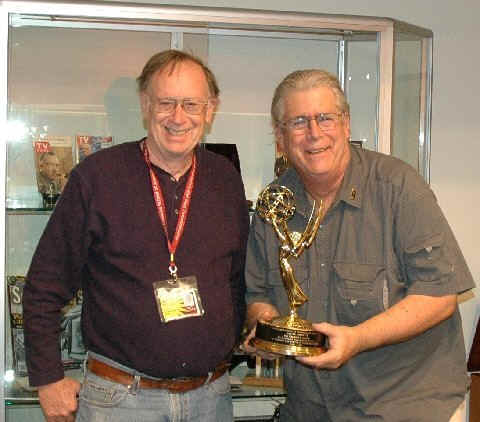
John Craft Professor
at Cronkite School of Broadcasting and Ed
Sharpe Archivist for the Southwest Museum Of Engineering,
Communications and Computation (SMECC) Examine
Walter Cronkite's Emmy (R) Award

Wonderful
display cases full of interesting items!
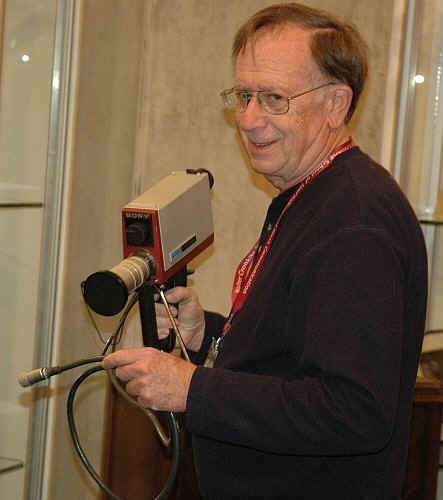
John
Craft making the AC-3400 Portapak Camera ready for the
display
This camera is one of the many artifacts on loan from
the Southwest Museum of
Engineering, Communications and Computation (SMECC) In Glendale
AZ
John
Craft making the AV-3400 Portapak recorder from the
early 1970's ready for the display. This portable
Sony Reel to Reel video recorder is one of the many artifacts
on loan from the Southwest Museum of Engineering,
Communications and Computation (SMECC) In Glendale AZ
John
Craft Professor at Cronkite School of Broadcasting and Ed
Sharpe Archivist for the Southwest Museum Of Engineering,
Communications and Computation (SMECC) making the JVC KY-1900
Camera and a 3/4 U-matic portable deck from the SMECC
Glendale museum ready go into the display case.
The Marguerite
and Jack Clifford Gallery
inside the ASU Cronkite School of Broadcasting in downtown
Phoenix houses a wonderful display of "The tools of
the Journalist" as well as mementos of Walter Cronkite..
Not
from the SMECC Collection... but this is NEAT!
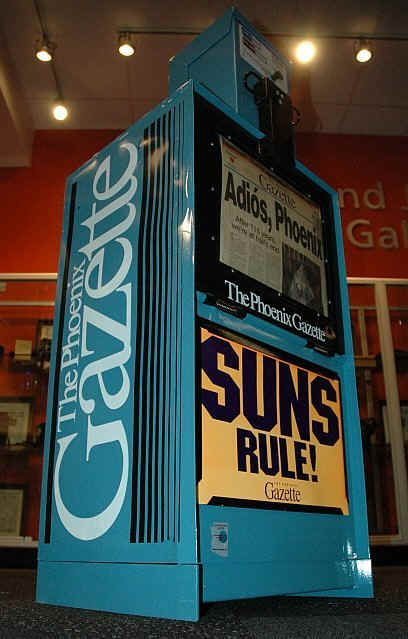
Last
Issue of the Phoenix Gazette displayed in a Gazette Vending
machine.
|
|
|

